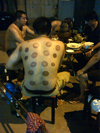|
fire cupping
Name of an
acupressure
technique used in traditional Chinese medicine,
known in
Chinese as
ba guan zi,
which literally means ‘to pull [with] jars’ or ‘pot pulling’.
In
English, the practice is also simply referred to as cupping. In
fire cupping, a partial vacuum is created in a cupping glass or jar, in Chinese
referred to as
ba guan, usually by means of
heat, which is then applied directly to the skin. The underlying tissue
is sucked up into the jar forming an area of blood stasis, bruising the
area, turning it a bright to dark red or even purple, akin to a love
bite. In ancient times, animal horns and
bamboo jars were used, but
today the cups are made mostly out of glass to standard sizes and
specifications, although bamboo jars are still occasionally used. The
method is used in the treatment of respiratory diseases, such as common
cold, pneumonia and bronchitis, as well as back, neck, shoulder and
other musculoskeletal pains. Though, other than the general benefits of
acupressure, there is no scientific proof that supports this technique
to cure any disease, yet it is widely practiced throughout Southeast
Asia, including in Thailand, where it is known as
kaan chai
thuay dood leuad, meaning ‘to make use of cups to suck
blood’. In
Vietnam,
the northern hill tribe people near the border with China use the
practice on the forehead in order to relief headaches and for it they still use
a cut-off tip of
buffalo
horn, which leaves them with small, round,
purple marks on the forehead (fig.).
回






|

